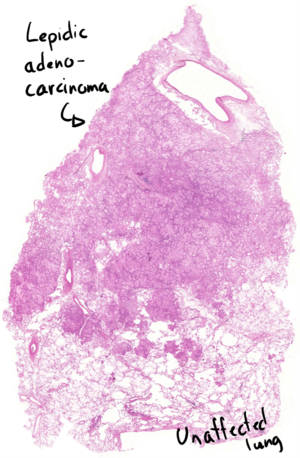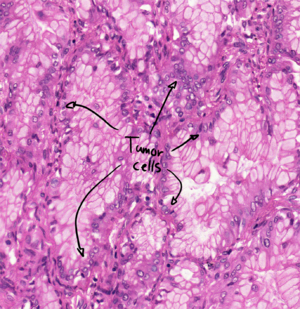51. Lepidic adenocarcinoma: Difference between revisions
(Created page with "'''Staining''': HE '''Organ''': Lung '''Description''': The slide has two zones. The lower zone shows healthy, unaffected lung parenchyme. The upper zone shows normal structure of the alveoli, however the insides of the alveoli are lined by tumor cells. '''Diagnosis''': Lepidic adenocarcinoma '''Causes''': * Genetic mutations ** EGFR ** KRAS ** ALK ** PDL-1 '''Theory''': Five types of lung adenocarcinomas exist: * Papillary type * Acinar type * Solid type * Mic...") |
No edit summary |
||
| Line 5: | Line 5: | ||
'''Description''': | '''Description''': | ||
The slide has two zones. The lower zone shows healthy, unaffected lung parenchyme. | The slide has two zones. The lower zone shows healthy, unaffected lung parenchyme. The upper zone shows normal structure of the alveoli, however the insides of the alveoli are lined by tumor cells. | ||
The upper zone shows normal structure of the alveoli, however the insides of the alveoli are lined by tumor cells. | |||
'''Diagnosis''': Lepidic adenocarcinoma | '''Diagnosis''': Lepidic adenocarcinoma | ||
''' | '''Risk factors:''' Asian ethnicity, smoking Genetic mutations | ||
'''Theory''': | '''Theory''': | ||
| Line 29: | Line 21: | ||
* Lepidic type (best prognosis) | * Lepidic type (best prognosis) | ||
This histology slide shows a “lepidic” growth pattern, which is the pattern where the tumor cells ''line'' the alveolar walls instead of invading the interstitium. The alveolar structure is therefore maintained. | This histology slide shows a “lepidic” growth pattern, which is the pattern where the tumor cells ''line'' the alveolar walls instead of invading the interstitium. The alveolar structure is therefore maintained. It’s technically an adenocarcinoma ''in situ'' because it hasn’t passed the basement membrane yet. Like other lung adenocarcinoma it's associated with mutations in EGFR, KRAS, ALK, PDL-1.[[File:Lepidic adenocarcinoma lung overview.png|center|thumb|Overview of the slide]] | ||
It’s technically an adenocarcinoma ''in situ'' because it hasn’t passed the basement membrane yet. | |||
[[File:Lepidic adenocarcinoma lung overview.png|center|thumb|Overview of the slide]] | |||
[[File:Lepidic adenocarcinoma lung lepidic growth pattern.png|center|thumb|The lepidic growth pattern. See how the cancer cell create a lining of the walls of the alveoli.]] | [[File:Lepidic adenocarcinoma lung lepidic growth pattern.png|center|thumb|The lepidic growth pattern. See how the cancer cell create a lining of the walls of the alveoli.]] | ||
[[File:Lepidic adenocarcinoma lung pleomorphism.png|center|thumb|Check out the pleomorphism of the tumor cells (anisochromasia, anisocytosis, anisonucleosis). Note that the tumor cells have large, pale cytoplasm. They belong to an ''adeno''carcinoma after all!]] | [[File:Lepidic adenocarcinoma lung pleomorphism.png|center|thumb|Check out the pleomorphism of the tumor cells (anisochromasia, anisocytosis, anisonucleosis). Note that the tumor cells have large, pale cytoplasm. They belong to an ''adeno''carcinoma after all!]] | ||
[[Category:Pathology 1 - Histopathology slides]] | [[Category:Pathology 1 - Histopathology slides]] | ||
Revision as of 12:58, 5 July 2024
Staining: HE
Organ: Lung
Description:
The slide has two zones. The lower zone shows healthy, unaffected lung parenchyme. The upper zone shows normal structure of the alveoli, however the insides of the alveoli are lined by tumor cells.
Diagnosis: Lepidic adenocarcinoma
Risk factors: Asian ethnicity, smoking Genetic mutations
Theory:
Five types of lung adenocarcinomas exist:
- Papillary type
- Acinar type
- Solid type
- Micropapillary type (worse prognosis)
- Lepidic type (best prognosis)
This histology slide shows a “lepidic” growth pattern, which is the pattern where the tumor cells line the alveolar walls instead of invading the interstitium. The alveolar structure is therefore maintained. It’s technically an adenocarcinoma in situ because it hasn’t passed the basement membrane yet. Like other lung adenocarcinoma it's associated with mutations in EGFR, KRAS, ALK, PDL-1.



